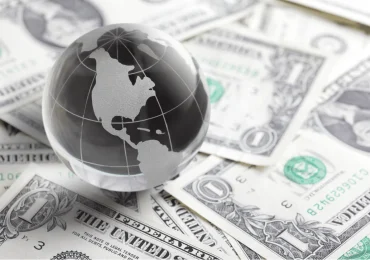The U.S. magazine Forbes marked its centennial anniversary on September 15, 2017. Over the past 100 years, Forbes magazine has covered every pivotal event in the U.S. economy. The rise of the U.S. economy has largely contributed to the growth and development of the media market, including Forbes magazine. On the other hand, Forbes made its own large contribution to the development of the U.S. economy. From the day of its founding to the present time, Forbes has remained committed to promoting and supporting business, particularly innovative newly-emerging entrepreneurs.
In this article we will discuss the development of the U.S. economy since 1917 (the year Forbes magazine was founded) to the present day.
In 2017, the GDP of the United States was $800 billion (expressed in 2005 constant prices). Over the past 100 years, the U.S. economy has grown 19 times and by 2017, GDP reached $15 trillion (expressed in 2005 constant prices), and nominal GDP (in current prices) will exceed $19 trillion.
The population of the United States one century ago was 103 million, now its three times larger (326 million). Such a high rate ofpopulation growth was prompted by immigration, increased life expectancy and natural increases. Unlike many other developed countries, the population of the United States has continued growing over the past decades. Its population has grown by 50% (100 million people) since 1980.
In 1917 per capita income in the U.S. was $7,500 (expressed in 2005 constant prices), in 2017 it will reach $46,000 and in current prices, per capita income will exceed $59,000.
Income fluctuation expressed in basic yearly prices (in this case in 2005 constant prices) indicates that the actual population welfare has increased due to the annulment of inflation. As it stands, economic welfare in the United States has increased six times.
Table1. US economic indicator
Economic indicators | 1917 | 2017 |
Population | 103 million | 326 million |
GDP (in 2005 constant prices) | $800billion | $15 trillion |
GDP per capita (in 2005 constant prices) | $7 ,500 | $46,000 |
Unemployment rate | 6% | 4.7% |
Employed persons | 35million | 154 million |
In 1917, the US economy made up 20% the world’s economy, reaching its highest (27%) in 1950. Since 1950, the share of the US economy has declined due to the rapid economic development ongoing in East Asian countries. In 2017, the U.S. economy comprised about 15.3% of the world’s economy. However, it should be noted that in 2014, China’s GDP at Purchasing Power Parity (PPP) was higher than that of the US.
If we measure economies by volume instead of value, China has been producing more products and services than the US since 2014. Prior to 2014, the last time China’s production exceeded US production was in the late 19th century. For instance, in 1980 the US economy was 9 times larger (in PPP prices) than the economy of China. However, when expressed in nominal terms, the US economy is still 1.6 times larger than the Chinese economy.
1917-1928
From1917-1929, the average annual growth rate of the US economy was 3%. This was during the post-World War I period, when state intervention in the economy started to grow. During World War I, the increase in budget expenditure led to an increase in taxes, which was maintained even after the war was over. The income tax calculated in GDP increased from 1% to 5%. The Federal Reserve System was established in 1913 in an effort to maintain the gold standard of the country’s currency system (the printing of papermoney was directly linked to gold). By that time, New York was already enjoying the status of being the world’s financial capital and the US economy was undergoing rapid electrification. Over one-third of the population was still employed in the agricultural sphere at this time.
Table 2. US employment structure, percent of total
Year | Agriculture | Manufacturing | Services |
1900 | 38.3 | 21 | 40.7 |
1950 | 10.5 | 24.8 | 64.7 |
1973 | 3.5 | 22 | 74.5 |
2016 | 1.6 | 18.4 | 80 |
1929-1947
Historically, the 1930s was the most difficult period in terms of the American economy in the 20th century. Despite the fact that there is no unanimous consensus as to what led to the greatest economic crisis (Great Depression) of the 20th century, it still does not change the severe consequences that ensued. The stock market was the most severely affected by the economic crisis – the New York Stock Market practically crashed. Unemployment reached 25%, 40% of US banks went bankrupt, foreign trade decreased by 60%, industrial production was halved and per capita income decreased by 40%. It wasn’t until 1940 that the US managed to regain the economic capacity it had in 1928. Practically twelve years of economic development was lost.
In the second half of the 1930s, the US government attempted to rescue the country from the economic recession through its active intervention. This intervention was mainly characterized by increasing budget expenditures and creating artificial incentives to bolster economic growth. Active cooperation between the state and the private sector was maintained during World War II, since there was an urgent need to intensify the production of war-related products and services. The rising demand for war supplies facilitate deconomic growth and in 1941-1943, annual average economic growth rate was 16%. From 1945-1947, the US economy decreased by 15%, which was mainly due to the end of war and the cessation of the economic boom.
1948-1972
The twenty-five-year period from 1948 to 1972, marked a period of economic renaissance in the western world, including the United States. After World War II, America undoubtedly became the world’s most powerful and influential economy. The United States establishedthe Marshall Program (officially the European Recovery Program), which was a US initiative aimed at aiding Western Europerebuild its economies after the end of World War. Within the framework of this program, the US provided significant support to Japan. All major economies, with the exception of the Eastern Bloc countries, valued their currencies against the US dollar, while United States had a gold standard monetary system. In other words, the US, with its gold reserves and economic strength, became a guarantor of credibility for the national currencies of approximately 50 major countries.
From1948-1972, the average annual economic growth in the US was 4%. The annual inflation rate was in the region of 0-6%, while the unemployment rate did not exceed 6.6%. Real per capita income (expressed in 2005 constant prices) increased from $13, 000 to $22,000.
1973-2000
The US economy abandoned the gold standard and moved to a free currency exchange rate with other countries. The oil crisis, also known as the ‘Oil Shock’ began in October 1973 when members of the Organization of Arab Petroleum Exporting Countries (OPEC) proclaimed an oil embargo targeted at nations perceived as supporting Israel during the war. The price of oil quadrupled. 1974-1975 were the years of stagflation and economic inertia, while the inflation rate kept rising. In 1973-1975 prices increased by 30% and the unemployment rate reached 8.2%.
The second ‘Oil Shock’ followed in 1979, and saw the price of oil double, as oil prices reached $39 per barrel(before 1973 oil sold at$3 per barrel). The US economy was still in a recession and the inflation rate began to rise. In 1982, the US unemployment rate reached 10.8%.
In the early 1980s, US President Ronald Reagan launched economic reforms, reducing income tax and government regulations, as well as tightening money supply in order to reduce inflation. At the same time, the budget deficit (4% of the GDP) and the national debt, continued to increase. From 1983-1989, the annual growth rate of the US economy grew by 4.4% on average. Stagflation was overcome, the unemployment rate returned to 5.4% and the annual inflation rate was in the region of 4%.
The United States’ economy entered a minor recession in the 1990s that was prompted by global fluctuations that resulted after the collapse of the Soviet Union. Since 1992, the economy of the United States grew steadily at between 2.7 and 4.5% and the country’s unemployment rate dropped to 3.9%. By the end of the century, the US economy no longer had a budget deficit.
The 21st Century
For the United States, the 21stcentury began with its much publicized ‘War on Terrorism’. In the aftermath of September 11, 2001 attacks, the United States increased its military spending from $300 billion in the year 2000 to$700 billion by 2009). Such a rapid increase in military spending prompted an increase in the budget deficit and rapid growth of the national debt. In 2001, the national debt stood at 53% of total GDP and by 2008 that number increased to 74% ($3.7 trillion). From 2001 to 2008 the average annual growth of the US economy was 2.5% and the unemployment rate was in the region of 5%. The end of 2007 marked the beginning of a painful financial crisis in the US. This crisis led to the Global Financial crisis and, in 2008-2009, it caused significant damage to the world’s economy. There are several factors that led to the financial crisis: a) the financial sector was not regulated adequately, which led to the emergence of financial pyramids and speculation; b) an excessive increase in money supply led to ‘financial bubbles’’ and c) state intervention in real estate credit market. The crisis intensified and resulted in panic after the Lehman Brothers filed for bankruptcy in September 2008. This was the largest bankruptcy in the history of the United States, as the assets of the company were worth approximately $600 billion.
In 2008, the US economy decreased by 0.3% and in 2009 it dropped by 2.8%. The unemployment rate reached 10% in 2010. The number of employed decreased by 7 million people. The Obama administration resorted to the Keynesian policy for economic recovery through increasing government spending and demand for more production, thus stimulating economic growth.
The US economy began growing in 2010 and by 2016,average annual growth rate reached 2.1% and unemployment dropped to it ‘natural rate’ of 5%. In 2009, the budget deficit reached its maximum of 13% of GDP ($1.9 trillion), then began dropping. By 2016, the budget deficit stood at 4.4%. In 2016, the national debt of the US reached $20 trillion, which is 107% of the GDP.
The US economic growth estimate for 2017 is projected at 2.3%. Economic forecasts suggest that unemployment will drop to 4.7% and the budget deficit will be 4% of the GDP. The state debt is predicted to reach 21 trillion dollars. The current president of the United State Donald Trump promised his voters sweeping economic reforms. However, the economic content of these promises are often contradictory. Even though it’s been almost a year since his election, Trump hasn’t found time for the economy. The US government has thus far mainly focused on foreign policy and security issues.
And finally in order to measure the prosperity of the US economy and business we can simply refer to the list of the world richest people published by Forbes Magazine, where 8 out of 10 are American entrepreneurs that have earned enormous capital and basically built the modern world.

















